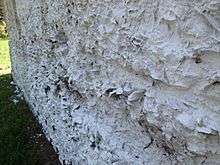Tabby concrete
Tabby is a type of concrete made by burning oyster shells to create lime, then mixing it with water, sand, ash and broken oyster shells. Tabby was used by early Spanish settlers in present-day North Carolina and Florida, then by British colonists primarily in coastal South Carolina and Georgia.

Revivals in the use of tabby spread northward and continued into the early 19th century. Tabby was normally protected with a coating of plaster or stucco.
Origin
.jpg)
Tabby's origin is uncertain. There is evidence that North African Moors brought a predecessor form of tabby to Spain when they invaded that kingdom: a form of tabby is used in Morocco today and some tabby structures survive in Spain, though in both instances the aggregate is granite, not oyster shells.
It is likely that 16th-century Spanish explorers first brought tabby (which appears as "tabee", "tapis", "tappy" and "tapia" in early documents) to the coast of Florida in the sixteenth century.[1] Tapia is Spanish for "mud wall" and Arabic tabbi means a mixture of mortar and lime[1] or African tabi.[2] In fact, the mortar used to chink the earliest cabins in this area was a mixture of mud and Spanish moss.
The oldest known example of Tabby concrete in North America is the Spanish Fort San Antón de Carlos located on Mound Key In Florida.[3]
Some researchers believe that English colonists developed their own process independently of the Spanish.
James Oglethorpe is credited with introducing "Oglethorpe tabby" into Georgia after seeing Spanish forts in Florida and encouraging its use, using it himself for his house near Fort Frederica.[1] Later Thomas Spalding, who had grown up in Oglethorpe's house, led a tabby revival in the second quarter of the 19th century sometimes referred to as "Spalding tabby".[1] Another revival occurred with the development of Jekyll Island in the 1880s.[1]
Regions of use
Limestone to make building lime was not locally available to early settlers, so lime was imported or made from oyster shells. Shell middens along the coast were a supply of shells to make tabby, which diffused from two primary centers or hearths: one at Saint Augustine, Florida, and the other at Beaufort, South Carolina.
The earliest known use of tabby was near Beaufort, South Carolina, formerly known as Santa Elena which was the capital of Spanish Florida from 1566 to 1587.[4]
The British tradition began later (some time close to, but earlier than, 1700, upon introduction of the techniques from Spanish Florida) than the Spanish (1580), and spread far more widely as a building material, reaching at least as far north as Staten Island, New York, where it can be found in the still-standing Abraham Manee House, erected circa 1670. Beaufort, South Carolina, was both the primary center for British tabby and the location of the earliest British tabby in the southeastern US. It was here that the British tradition first developed, and from this hearth tabby eventually spread throughout the sea island district.
Tabby was used in the West Indies, including the islands of Antigua and Barbados.[5]
Process
The labor-intensive process depended on slave labor to crush and burn the oyster shells into quicklime. The quicklime was then slaked (hydrated), combined with the shells, sand and water then poured or tamped into wood forms called cradles, built up in layers in a similar manner to rammed earth. Tabby was used as a substitute for bricks, which were rare and expensive because of the absence of local clay.
Tabby was used like concrete for floors, foundations, columns, roofs or was made into bricks or used as "oyster shell mortar" or "burnt shell mortar".
Significant examples
- St. Simons Island Light, Georgia (foundation only)
- Wormsloe Plantation house ruins, Isle of Hope, Georgia
- McIntosh Sugarmill, Camden County, Georgia
- Horton House, Jekyll Island, Georgia
- Slave quarters at Kingsley Plantation, Fort George Island near Jacksonville, Florida
- Isaac Fripp House Ruins, Saint Helena Island near Frogmore, South Carolina
- Along Florida's west coast, Gamble Plantation Mansion, Ellenton
- George Adderley House in Marathon, Florida
- Colonial Dorchester State Historic Site near Charleston, South Carolina[6]
- Tabby Manse (Thomas Fuller House), Beaufort, South Carolina
References
- Morris, Susan D. "Tabby". New Georgia Encyclopedia. University of Georgia Libraries, 12/10/2005 Last edited by NGE Staff on 09/24/2014. Accessed April 12, 2015
- Lauren B. Sickels-Taves and Michael S. Sheehan, The Lost Art of Tabby Redefined: Preserving Oglethorpe's Architectural Legacy. Southfield, MI: Architectural Conservation Press. 1999. 2. Print
- "Archaeologists verify Florida's Mound Key as location of elusive Spanish fort". phys.org. Retrieved 2020-04-26.
- Manucy, Albert C., "Tapia, or Tabby" The Journal of the Society of Architectural Historians Vol. 11, no. 4 (1952): 32 quoted in Jessica Golebiowski "Rammed Earth Architecture's Journey to the High Hills of The Santee and its Role as an Early Concrete". Thesis. Clemson University & The College of Charleston. 2009. 32. Print.
- Gall, Michael J.; Veit, Richard F. Archaeologies of African American life in the upper Mid-Atlantic. pp. 62–63. ISBN 9780817391508. Retrieved 29 January 2020.
- https://southcarolinaparks.com/colonial-dorchester
- Adams, Dennis. "Tabby: The Oyster Shell Concrete of the Low Country". Beaufort County Library. Retrieved 29 August 2012.
External links
- "Tabby: The Oyster Shell Concrete of the Lowcountry", Beaufort County, South Carolina Public Library.
- Colin Brooker, "The Conservation and Repair of Tabby in Beaufort County, South Carolina", revised version of formal talk, "The Conservation of Tabby in Beaufort County, South Carolina," given at Jekyll Island Club Hotel, Jekyll Island, Georgia, on February 25, 1998.
- Paper on Tabby by the Henry Ford Museum
- Tabby historical marker at Jekyll Island
| Wikimedia Commons has media related to Tabby buildings. |